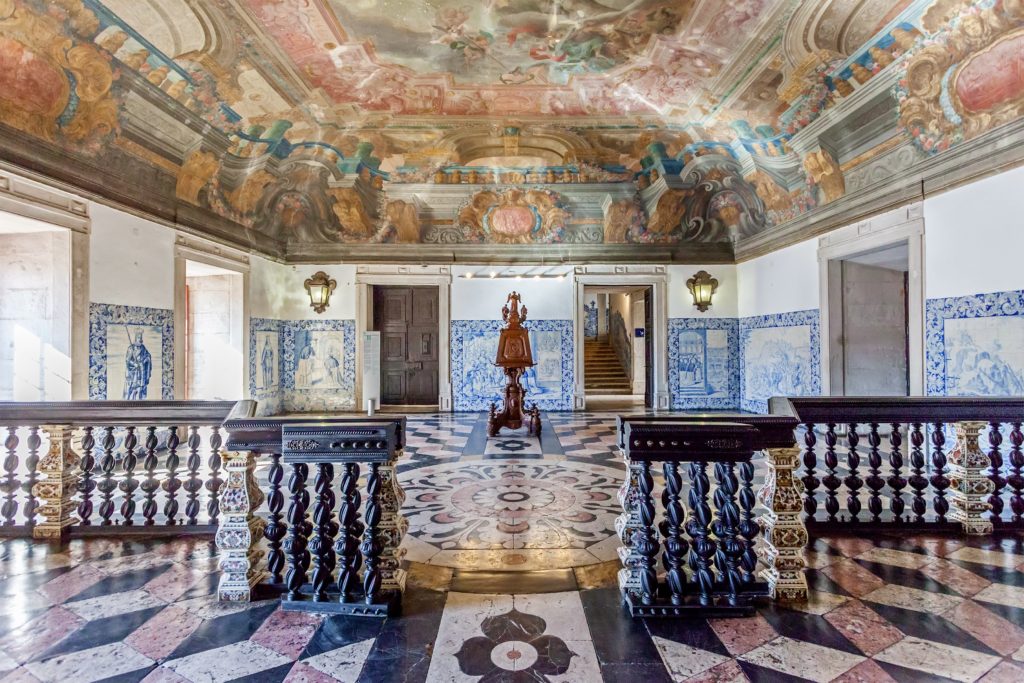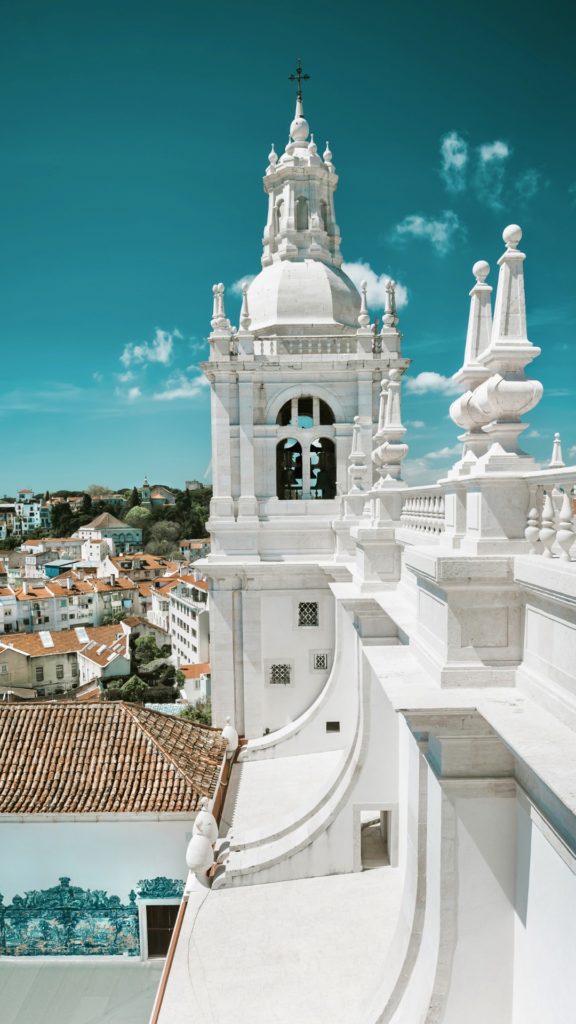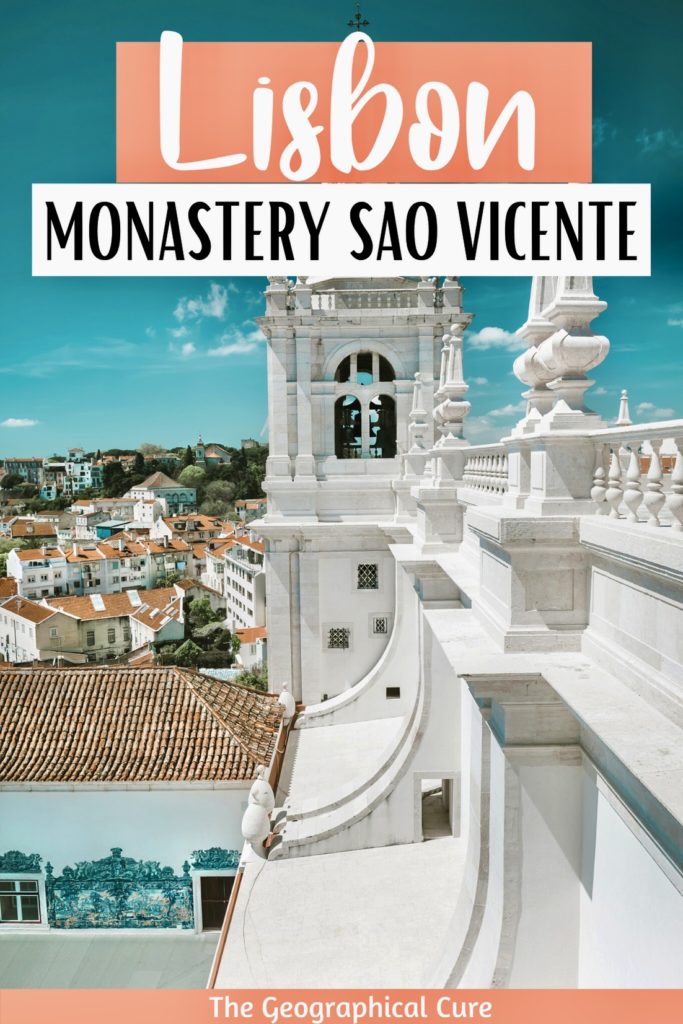Looking for some unusual things to do in Lisbon? Head to the Monastery of São Vicente de Fora. It’s one of Lisbon’s grand architectural sites and still a hidden gem in Lisbon.
In fact, the monastery is hidden in plain sight, sitting atop one of Graça’s highest points, not far from the Alfama district. Yet few tourists venture inside. That’s a mistake.
The 16th century Monastery of São Vicente de Fora is jaw dropping.
If you don’t want to journey to the Jerónimos Monastery in the suburb of Belem or pay its rather hefty fee to see the cloisters, this monastery is a fantastic alternative.
It’s inexpensive, crowd free, and has a killer rooftop view. You can get a good view of the monastery itself from St. George’s Castle in Alfama.
The monastery was commissioned by King Phillip II of Spain (who then ruled Portugal) and designed by Filippo Terzi. It’s dedicated to St. Vincent, who was proclaimed Lisbon’s patron saint in 1173.
The monastery has a sober ivory colored facade, built in the late Italian Renaissance style known as Mannerism.
There are two towers on the sides and three arches leading to the entrance hall. Statues of saints Augustine, Vincent, and Sebastian peer down over you.
The monastery is the burial place of kings and many saints have passed through its doors.
But the most compelling reason to visit the monastery is its richly decorated and sun-dappled cloister with its 18th century azulejos.
Everywhere you look, the cloisters are covered in stunning azulejo mosaics telling historical stories. No flat surface is left untiled.

Guide To The Monastery of São Vicente de Fora
Here’s everything you should see inside the monastery.
Once inside, you enter into a grand Baroque-style entry hall. It’s decorated with 18th century blue and white azulejos telling the story of the monastery. The ceiling has an illusionistic painting by Vincenzo Baccarelli.
There’s not any furniture. But there is a reliquary chest containing the bones of 16th century martyrs.
Upstairs, an unbroken tiled pattern winds throughout the entire monastery. 100,000 tiles were used, making it the world’s largest collection of Baroque tiles.
Few things are as distinctly Portuguese as azulejo tiles. But the art form was originally Arabic. The word “azulejo” derives from the Moorish word az-zulayj meaning “polished stone.”
Legend holds that when King Manuel I of Portugal visited the Spanish province of Seville in the 15th century, he was completely taken with the Royal Alcázar.
He decided to have his own palace — Pena Palace in Sintra 30 minutes from Lisbon — decorated with the same style of ceramic azulejo tiles. Imitation is the most sincere form of flattery, right?
As well as the azulejo cloisters, there are scenes (historically inaccurate ones) of Afonso Henriques attacking Lisbon. 28 gorgeous panels also illustrate the stories of Jean de La Fontaine.
He was a popular 17th century French fabulist and poet. His literature was both wise and satiric, pointing out the consequences of sin (vanity, idleness, and extravagance) and the rewards of kindness and hard work.
Some of the azulejo fables are pretty funny or poignant actually. In one fable, a lonely man and a lonely bear befriend each other. The bear kept flies off the man’s face when he slept.
But, one day, the bear threw a rock at a fly on the man’s nose. The man dropped dead. The moral: don’t be lazy and wear a sun hat to keep flies away.
There’s another fable for cat lovers. In this one, a weasel stole a rabbit’s warren. The weasel claimed title by seizure (a practice Portugal itself used during the Age of Discoveries), disavowing hereditary claims.
The animals selected a cat to judge their dispute. The cat gobbled them both up. The moral: Don’t trust cats and build your own home.
Aside from the azulejos, there are two other things not to miss, the sacristry and the Braganza Pantheon which are in the church museum.
The sacristy is a stunner, famous of its different kinds of marble. Built in the 18th century, it has vibrant multi-color inlaid marble walls covered in floral patterns.
The Braganza Pantheon is right under the sacristy housed in the former refectory. It’s home to the tombs of the Portuguese kings from the house of Braganza, who ruled from 1640 to 1910. The tomb of Joao IV takes pride of place.
When you’re done admiring the finery, head up to the rooftop for a fantastic bell tower view. It’s one of the best views of Lisbon.
So if you’re wondering whether the Monastery of São Vicente de Fora is worth visiting, the answer is a decided yes!
Practical Information And Tips for Visiting the Monastery of São Vicente de Fora :
Address:
Largo de São Vicente, 1100-572 Lisboa. The monastery is just to the right of the church steps.
You can get there by taxi, bus, or walking. If you’re in the Alfama, the monastery is a 10 minute walk from St. George’s Castle.
Hours: Open daily Tues to Sun from 10:00 am to 6:00 pm. Closed Monday.
Entry fee:
Access to the rather dull church is free and is often open only during mass. It’s 5 euros to see the real treasures — the cloister, crypt, cistern — and have access to the rooftop.

Pro tip:
You can take Tram 28 to the monastery. Get off at Largo da Graca and follow the signs.
If you visit on a Tuesday or Saturday, you can also inspect the famous Feira da Ladra flea market, which is held behind the church.
Guided Tours: You can see the monastery on a private guided tour of Lisbon. You’ll also cruise by it on a Lisbon on wheels tour.
I hope you’ve enjoyed my guide to the Monastery of São Vicente de Fora. You may enjoy theses other Portugal travel guides and resources:
- 10 day itinerary for Portugal
- Historic landmarks in Portugal
- 4 day itinerary for Lisbon
- 2 days in Porto itinerary
- 1 day in Coimbra itinerary
- Guide to Lisbon’s Alfama neighborhood
- Guide to Lisbon’s Belem neighborhood
- Guide to Pena Palace
- Day trips from Lisbon
- Tips for Visiting Sintra
If you’d like to visit one of Lisbon’s hidden gems, pin it for later.

